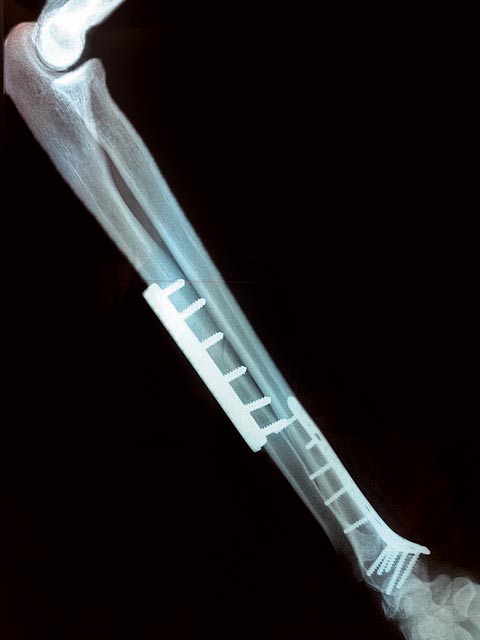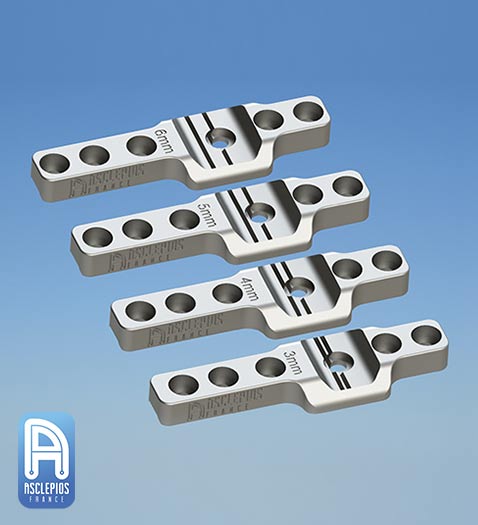Ulna osteotomy ancillary
In recent years, we’ve seen the ancillaries aiming to shorten the ulna thrive. It is true that the freehand gesture was technical, long and delicate. The ‘Asclepios Innovation’ solution is radically innovative because of its simplicity of implementation. The ulna osteotomy becomes simple, adjustable, precise, reproducible in about twenty minutes.
What is the ancillary?
A drilling guide and a cutting guide.
How to adjust its cutting width?
The cutting guide must be chosen according to the area (in millimetres) to be subtracted from the ulna: 3,4,5 or 6 mm.
What type of plate induces the use of the ancillary?
It uses a proven material: the DCP (Dynamic Compression Plate) stainless steel 6 holes plate and screw small fragments 3.5 mm AO.
It is accepted that the screws locked in the plates have greater rigidity. Why not to choose a locked plate rather than an unlocked DCP plate?
The DCP plate is short and the holes are better positioned to accept the osteotomy line. The pressure confrontation of the two bone slices is extraordinary.
The DCP plate is very stiff. The stability gain that lockable screws would bring is not decisive in the case of an ulnar osteotomy because the assembly benefits from the protection of the second bone of the forearm: the radius which is in continuity.
Why not put a 7th oblique screw, in compression, perpendicular to the line?
This 7th screw (in compression) would be redundant because the compression is already excellent, without this screw, thanks to the perfect guidance of the saw, the short length of application of the plate and the compression of two eccentric screws ‘DCP’.
The addition of a screw would require the use of a plate with 7 holes. Therefore, a longer one. And, it is more difficult to find a really straight ulna surface over a longer length. An authentic straightness minimises incongruence between plaque and bone; incongruence which could be at the origin of a lack of confrontation of the osteotomy line.
The ancillaries already available are very accomplished. What does Asclepios really bring on the subject?
The other technical solutions of engineers are sophisticated because they tend towards the sale of a dedicated locked plate.
But for the surgeon, the effort of learning such an ancillary is to provide again each new shortening because the indications are rare and therefore spaced in time.
Asclepios is not subordinated to the sale of osteosynthesis equipment. The design can afford to be both radically innovative and incredibly sober: a drilling guide and a cutting guide. Simplicity is luxury...
About twenty minutes. Really?
Actually, there is no ancillary setting, only 6 holes, 4 screws, osteotomy and 6 screws: the gesture is very fast. This astonishing speed allows, if necessary, the association with an angular correction of the radial glenoid during the same tourniquet time, the ulna bone washer can then serve as a radial graft.
If one wants to tap rather than using self-tapping screws, is it possible?
Yes, the choice of tapping or not is up to the operator: the ancillary is intended to accept the passage of a tap in 3.5.
Small precaution, in case of tapping: it is advisable to measure the size of the screws before tapping. This is in order to avoid being deceived by the possible blockage of the end of the meter in a tapping groove, what could distort the measurement.
What sizes should we expect on average?
In practice, the screws are mainly between 14 and 18.




